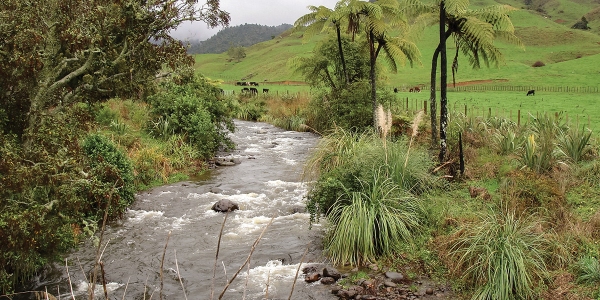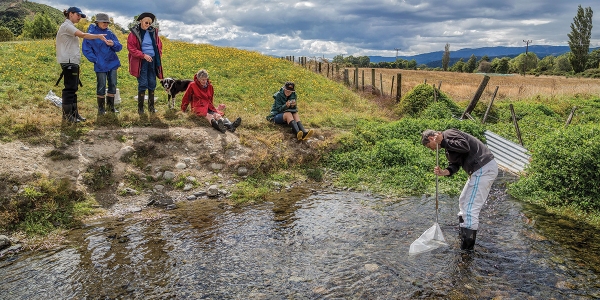NIWA's Freshwater and Estuaries Chief Scientist Dr John Quinn believes the dairy industry has been responsive in the tools it has adopted to reduce its impact on waterways.
“There has been a lot of improvement in dairy industry practice in the last 15 years. Dairy shed effluent management has improved and is more professional, and the majority of streams on dairy farms are now fenced to exclude cows. Things like the Farm Enviro Walk Toolkit and Sustainable Dairying Water Accord have increased adoption of a range of good environmental practices. These advances have been industry-led, rather than driven by government rules.”
Quinn notes, however, that the reduction in impact per farm has been offset by the expansion of dairying into areas that used to be dominated by drystock farming, which generally has a smaller footprint.
That is why Quinn still thinks the single biggest thing that can be done to improve our environment is to reduce the footprint of agriculture to both meet the nation’s greenhouse gas reduction commitments and improve freshwater quality and ecosystem health. And to incentivise this by finding high value markets that will pay for the value of advanced environmental practices and associated healthy food.
“It’s a big ‘single thing’ to complete, but without that level of strategy the little things any of us do won’t really matter,” he says.
In the shade
More than 97% of streams running through dairy farms are now fenced, so cows are out of waterways. Waterways are still receiving E. coli and Campylobacter from other unfenced stock and wild animals. They’re also getting microbial pathogens from land runoff when it rains. A 2005 NIWA study found that rain can wash a million to a billion E. coli bacterium per square metre of hillside into streams.
Riparian strips can help. These are the areas where plants grow alongside streams. They trap and absorb nutrients and microbes, including E. coli, in surface water. In the best conditions, riparian strips can remove at least 60% of nitrogen and 65% of phosphorus from runoff and groundwater.
There’s even more to riparian strips than the benefits to water quality. Trees holds together river banks, which stabilises them as habitats for insects and prevents silting and cloudy water that disturbs fish. The shade of trees creates cooler and more humid conditions, which insects need, and prevents over-growth of plants in the stream. Their branches and leaf litter provides direct habitat and food for many of the insects that like riverside conditions for only parts of their life stages, particularly larval, before moving to other habitats.
NIWA has recently started two new programmes looking at riparian management.
One project will work with highly trained and supported citizen scientists to use existing riparian restoration projects as a “natural experiment” to identify design features that result in success over the next four years.
The other will develop riparian and constructed wetland design methods that achieve better water quality outcomes while minimising implementation costs. It will focus on the known hotspots of runoff and transport of contaminants.
Citizen swim test
People are becoming alarmed to find water quality warnings in largely populated spots where councils conduct regular microbial testing.
Resource limitations mean that not all spots on a river can be checked, and it’s often up to the public to use their own judgment as to water quality.
“This is particularly a problem for rivers where potentially toxic algae (cyanobacteria) can be present in numerous places,” says NIWA Resource Management Scientist Juliet Milne.
“Public concern about the quality of our rivers and lakes has led to increasing interest in water management and monitoring—there is a growing move towards ‘citizen science’, with community groups wanting to do their own monitoring,” says Milne.
Community groups want to measure real-time changes in a waterway’s appearance such as rubbish present, odour, deposited sediment, and nuisance plant growth, which all influence perceptions of water quality and “swimmability”.
“Ultimately, monitoring will better reflect what people care about,” says Milne. NIWA is educating community groups and local residents on how to monitor waterways in the regions. Since the 1990s, NIWA has provided environmental community groups and farmers with the NIWA-designed Stream Health Monitoring and Assessment Kit (SHMAK) to self-monitor waterways. NIWA recently updated the kits to include an E. coli test for use in a study testing the efficacy of community monitoring. The results from community monitoring efforts in nine regions were then compared with regional council-collected data.
“The results matched well enough to show there is a real role for citizen science in New Zealand,” said NIWA Freshwater Ecologist Dr Richard Storey, who has conducted extensive research into community-based monitoring of New Zealand streams.
“Councils can only afford to monitor waterways on a limited basis. There are more than 600 volunteer environmental care groups in New Zealand and there is an increasing desire to take positive action, including monitoring. By empowering community groups to undertake testing themselves, and providing them with testing equipment, we can increase the amount of accurate monitoring around the country.”
NIWA is now working on an app that will allow users to upload monitoring data from mobile devices to a purpose-built public website providing real-time, user-friendly information about water safety and swimmability.
[This feature appeared in Water & Atmosphere 18]
Next article on Stepping into the river: Nature knows best.


